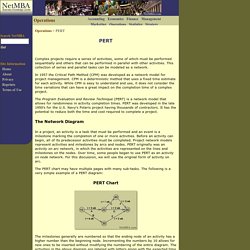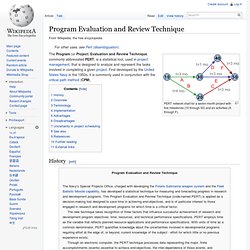

29566881 metodos-pert-cpm. CPM - Critical Path Method. Operations > CPM CPM - Critical Path Method In 1957, DuPont developed a project management method designed to address the challenge of shutting down chemical plants for maintenance and then restarting the plants once the maintenance had been completed.

Given the complexity of the process, they developed the Critical Path Method (CPM) for managing such projects. CPM provides the following benefits: Provides a graphical view of the project.Predicts the time required to complete the project.Shows which activities are critical to maintaining the schedule and which are not. CPM models the activities and events of a project as a network.
CPM Diagram Steps in CPM Project Planning Specify the individual activities.Determine the sequence of those activities.Draw a network diagram.Estimate the completion time for each activity.Identify the critical path (longest path through the network)Update the CPM diagram as the project progresses. 1. 2. Some activities are dependent on the completion of others. 3.
PERT Chart. Operations > PERT Complex projects require a series of activities, some of which must be performed sequentially and others that can be performed in parallel with other activities.

This collection of series and parallel tasks can be modeled as a network. In 1957 the Critical Path Method (CPM) was developed as a network model for project management. CPM is a deterministic method that uses a fixed time estimate for each activity. While CPM is easy to understand and use, it does not consider the time variations that can have a great impact on the completion time of a complex project. The Program Evaluation and Review Technique (PERT) is a network model that allows for randomness in activity completion times. The Network Diagram In a project, an activity is a task that must be performed and an event is a milestone marking the completion of one or more activities. The PERT chart may have multiple pages with many sub-tasks. PERT Chart Steps in the PERT Planning Process 1. 2. 3. 4. 5. 6.
Critical path method. The critical path method (CPM) is an algorithm for scheduling a set of project activities.[1] History[edit] The critical path method (CPM) is a project modeling technique developed in the late 1950s by Morgan R.

Walker of DuPont and James E. Kelley, Jr. of Remington Rand.[2] Kelley and Walker related their memories of the development of CPM in 1989.[3] Kelley attributed the term "critical path" to the developers of the Program Evaluation and Review Technique which was developed at about the same time by Booz Allen Hamilton and the U.S. Navy.[4] The precursors of what came to be known as Critical Path were developed and put into practice by DuPont between 1940 and 1943 and contributed to the success of the Manhattan Project.[5] CPM is commonly used with all forms of projects, including construction, aerospace and defense, software development, research projects, product development, engineering, and plant maintenance, among others.
Basic technique[edit] Crash duration[edit] Expansion[edit] Program Evaluation and Review Technique. PERT network chart for a seven-month project with five milestones (10 through 50) and six activities (A through F).

The Program (or Project) Evaluation and Review Technique, commonly abbreviated PERT, is a statistical tool, used in project management, that is designed to analyze and represent the tasks involved in completing a given project. First developed by the United States Navy in the 1950s, it is commonly used in conjunction with the critical path method (CPM). History[edit] Program Evaluation and Review Technique The Navy's Special Projects Office, charged with developing the Polaris-Submarine weapon system and the Fleet Ballistic Missile capability, has developed a statistical technique for measuring and forecasting progress in research and development programs.
Overview[edit] PERT is a method to analyze the involved tasks in completing a given project, especially the time needed to complete each task, and to identify the minimum time needed to complete the total project.